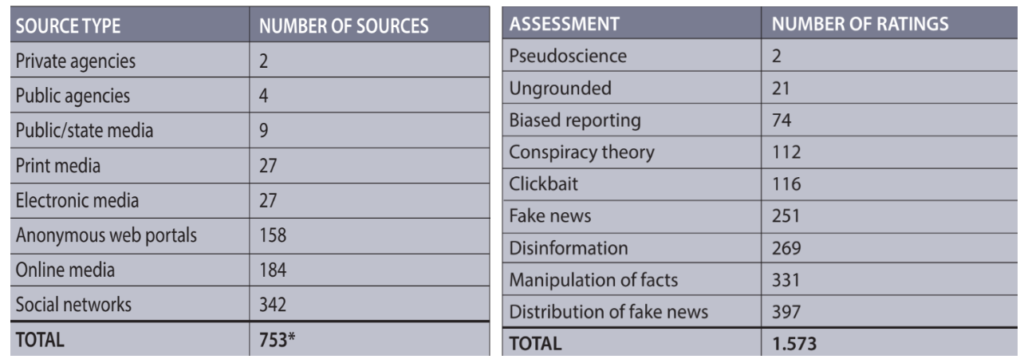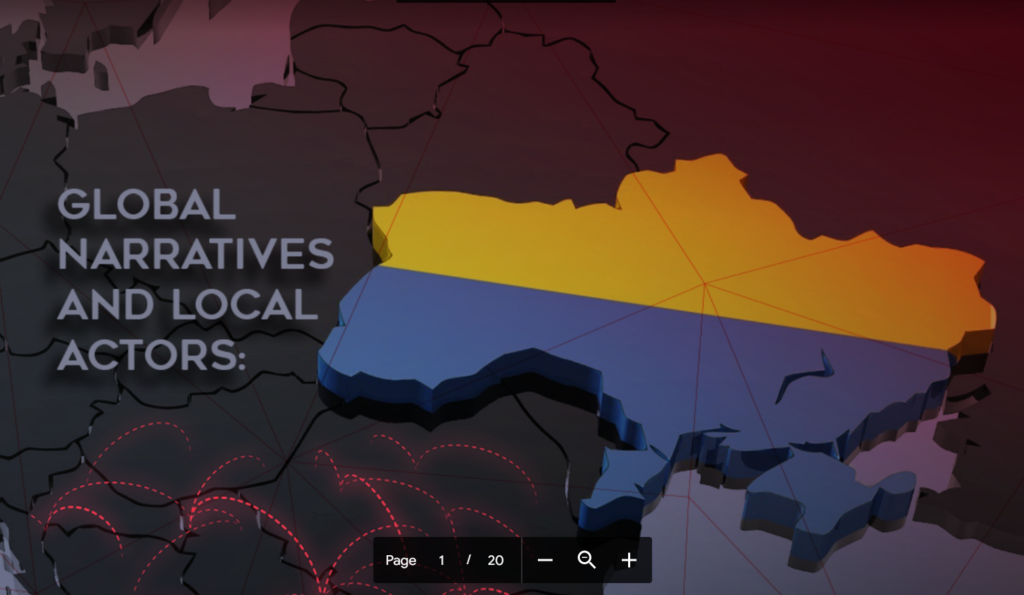The renewed open war in Ukraine has been going on for more than 150 days, but the spread of fake and manipulative news on this topic has been going on for much longer. Nevertheless, a real flood of misinformation and Russian propaganda about the war in this country in the Western Balkan region began to spread before the very outbreak of the conflict on February 24. From then until July 24, fact-checking platforms rated more than 1,396 media articles and posts on social networks in the region that discuss the war in Ukraine as manipulative or inaccurate. Therefore, the SEE Check network is based on the data created as a result of the work of five regional fact-checking platforms: Raskrinkavanje.ba (BiH), Raskrikavanje.rs (SRB), Fakenews.rs (SRB), Raskrinkavanje.me (MNE) and Faktograf.hr (CRO), published research on the most widespread disinformation claims and narratives about the war in Ukraine during the first 150 days, or five months of the conflict, as well as the most common sources of such claims in the region.
Due to the same or similar language area, most countries gathered in the regional SEE Check network of fact-checking web portals – Montenegro, Bosnia and Herzegovina, Croatia and Serbia, the same or similar content dominate social networks. In the context of the war in Ukraine, these are mostly pro-Russian narratives that aim to portray Ukraine as a “Nazi” country, and Russia as a country that comes to help the citizens of Ukraine. In a much smaller number, disinformation that supports the Ukrainian side is also present in the region.
In addition to social networks, in some countries, such as Serbia, pro-Russian manipulative media content dominated the “mainstream” media because such a narrative is largely in line with the unofficial position of official politics in Serbia. However, at least officially, the Serbian authorities did not take one’s position or side. The data show that the media from Serbia are the most common sources of misinformation for the entire region, and tabloids dominate among them, which, without exception, are politically sympathetic to the current authorities. Of the 20 individual sources with the most rated articles, 16 are from Serbia, two from Montenegro and two from Bosnia and Herzegovina. One of the comparative narratives in Serbia is the one about the pressure that this country suffers due to the non-introduction of sanctions against Russia, so sometimes, based on the media texts of the most widely read media, it can be concluded that the Serbian authorities are greater victims of this war than the Ukrainian people themselves. The situation is similar in Bosnia and Herzegovina, where in the entity of the Republic of Srpska and the public media, Radio and Television of the Republic of Srpska, and the news agency SRNA participate in the promotion of pro-Russian narratives, along with some other “mainstream” media. There are also some web portals in Montenegro and Croatia that tend to spread Russian disinformation, favor the Russian side and justify the Russian invasion.
On the other hand, web portals that make up the regional SEE Check network of fact-checking portals in a joint live blog about the war in Ukraine (BHSC/ENG) have been informing the public daily about the latest disinformation in the region since the Russian invasion. Five regional fact-checking web portals published a total of 313 analyzes during the first 150 days of the war in Ukraine, from February 24 to July 25, 2022, in which 1,396 articles and social media posts were rated as manipulative or inaccurate. Only 274 articles and publications were subsequently corrected after evaluation by the fact-checking web portal. A total of 1,573 inaccurate and manipulative claims were recorded in the region, most of which are part of Russian propaganda that has found its way into the countries of Southeast Europe.
This is just part of the data derived from the analysis of all fact-checking articles published in the joint live blog about the war in Ukraine during the first 150 days of the Russian invasion of Ukraine, as well as the articles and claims that were evaluated in them. In the publication published by the SEE Check network, you can find a more detailed overview of the most important disinformation claims and narratives noticed so far by the SEE Check network fact-checking journalists in connection with this conflict. The narratives identified as the most widespread are:
- Justifying the invasion by accusing Ukraine of Nazism, biological, chemical and nuclear weapons, planned attacks on Russia…
- Justifying the invasion by accusing the West of the presence of NATO, the development of biological and chemical weapons, planned attacks on Russia, Nazism…
- The use of manipulative terminology such as the phrases “special operation” or “counteroffensive
- Glorification of Russia and fabricated support for Russia, Putin and the Russian army
- Discrediting Volodymyr Zelensky and accusing him of Nazism, fleeing the country, cocaine…
- Denying accusations of Russian crimes and simultaneously accusing Ukraine of crimes
- Fake news about fake news
- Pro-Ukrainian disinformation
- “Fitting” the invasion into the narratives of popular conspiracy theories
The pro-Ukrainian disinformation noticed by the SEE Check network’s journalists mainly spreads unfounded stories about the heroism of the Ukrainian army and civilians. The biggest difference compared to the pro-Russian disinformation discourse is that there is much less news like this, they are not so viral, they do not have sources in officials and institutions, nor do they have a wide range of topics, unlike Russian propaganda narratives.
In addition to a qualitative review of narratives, the research also provides a quantitative analysis of disinformation claims of Russian propaganda in the region, as well as their sources.
The quantitative part of the research thus brings answers to the following questions:
- How much misinformation and manipulation has been published in the region
- What are the most common types of such manipulations
- Which types of media publish the most misinformation
- What are the most common individual sources of misinformation
- On which social networks and platforms are there the most sources of misinformation
In short, Facebook is a social network with the most different sources that published misinformation about the war in Ukraine, the media from Serbia mostly misinformed about this topic, while even news agencies and state media from the region participated in the spread of Russian propaganda.



You can find the complete publication on this link.

